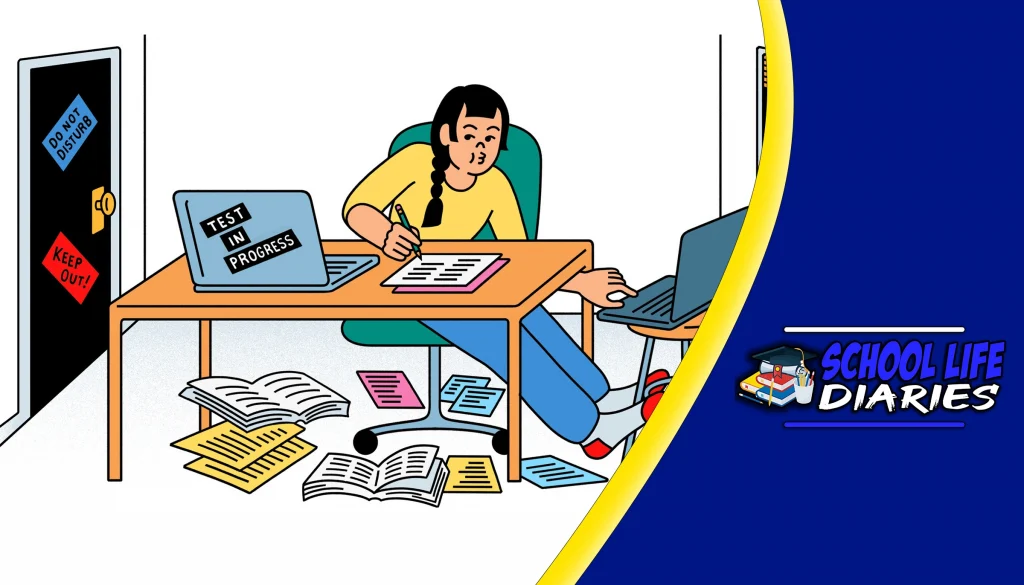Yes, Canvas does track tabs if a student switches between tabs during a proctored exam, the canvas will be able to detect the switching and alert the proctors. Every time you open a new window, focus on a tab, or move between tabs, it’s recorded in the Canvas Activity Stream. This allows the canvas to see which pages students are accessing and for how long.
Canvas has recently changed to allow tracking student interaction with course communication tools such as announcements and conversations. This additional tracking data helps Canvas determine if students are staying connected and up-to-date with course activities.
What is Canvas?
Canvas is an online learning management system used by institutions of higher learning to provide access to course materials. Instructors can post syllabi, lecture notes, assignments, and other resources online for students to access. Students can also use Canvas to submit their work and track their progress through the course. Canvas also allows instructors to easily grade online assignments, surveys, and quizzes.
How Does Canvas Work?
1. Students can access quizzes in Canvas by clicking on the Assignments tab and locating the quiz under the desired course.
2. If a student is taking a quiz for the first time, they will be prompted to enter their name and student ID number.
3. After submitting their information, students will be able to take the quiz.
4. The quiz will be displayed on the screen, and students will have the opportunity to review their answers before submitting them.
5. Once all questions have been answered, students will click on the “Submit” button to finish the quiz
How to Install Canvas on Windows 8/10/11?
1. Open the Microsoft Store.
2. In the search bar, type “Canvas” and press Enter.
3. Go to the official website and download the installer for Windows.
4. Click the “Install” button.
5. Double-click on the installer and follow the instructions.
6. After the installation is complete, click the “Launch” button.
7. Sign into Canvas with your email address and password that you use for logging in to the university website.
8. In the left hand navigation menu, click on Courses and select the name of the course you wish to access.
9. Click on Modules in the top navigation menu of your course page to view all available.
Can Canvas Track Your Tabs or Switching Tabs?
Yes, the canvas can track your tabs and switch tabs. Every time you switch tabs, Canvas logs an event and can tell if the user is actively engaged with the content or has switched away from it. Canvas stores and tracks tabs from a student’s history, such as which websites and tabs they have visited.
It also collects information about their search queries so it can provide tailored suggestions and help them find what they are looking for. This ensures that Canvas users are getting the best experience possible out of the platform, as well as providing insights into how the platform is being used.
Can Canvas Detect Screen Sharing?
No, Canvas does not detect screen sharing. Screen sharing is a feature that allows two or more users to see the same screen on their devices. It can be used for presentations, collaborations, and support sessions. If you are in a meeting and would like to share your screen.
You must do this manually by pressing the “Share Screen” button. This is a security measure taken by Canvas that ensures your safety while using the platform. No one else can detect when you are sharing your screen, but this feature could be added in the future.
Can Canvas Detect Screenshots?
Yes, Canvas can detect screenshots. It uses a screenshot detection algorithm to identify the difference between authentic work and screenshots. No matter what device or platform your students are using, Canvas can detect if they have taken a screenshot of someone else’s work and flag it appropriately.
This helps ensure that your course is relying on original, legitimate student work without any plagiarism or cheating. With Canvas’ screenshot detection algorithm, you can rest assured that your students are representing their own knowledge and creativity.
Can Canvas Detect Split Screen?
No, Canvas does not detect split screens. Canvas does not support split screen functionality for the connected device. While Canvas does have some integrations that provide proctoring services, like Respondus Monitor and Proctorio, these can offer split screen detection. If a user is attempting to take an exam in Canvas with the intention of using multiple screens or devices, it would be up to the instructor to manually detect any potential cheating or fraud.
Can Canvas Detect Copy Paste?
Yes, Canvas can detect copy-paste. Canvas has an originality detection feature that allows instructors to check the authenticity of student work. The tool uses natural language processing algorithms to analyze submitted assignments for any potential signs of plagiarism. If there is a match, Canvas will provide an alert to the instructor and highlight any matching material in the document. This feature helps ensure that students are submitting their own, original work.
Can Canvas Detect cheating?
Yes, Canvas can detect cheating. Canvas has a suite of features and tools that allow instructors to detect cheating while students are taking assessments. For example, the proctoring tool in Canvas enables instructors to use a webcam and microphone to monitor student activity during an assessment. Canvas can flag suspicious activity such as copying and pasting text from another source or having multiple browser tabs open.
Canvas also has an auto-suspicion flagging system that can detect plagiarism and cheating even when instructors are not actively monitoring the assessment. This system uses advanced algorithms to compare student submissions with other sources, such as online content or previously submitted assignments, and then flags any suspicious similarities for further investigation.
Can Canvas Track Your IP Address?
Yes, the canvas can track your IP address. Whenever you log into Canvas, your IP address is automatically logged in the activity log. This helps Canvas detect any suspicious activities and ensure the privacy and security of users.
Your IP address can also be used to determine your geographic location, which helps Canvas personalize your user experience by providing localized content. Canvas also keeps track of your account activity, including assignment submissions, course progress, and other important information.
Can Canvas Track Two Devices Tabs?
Yes, Canvas can track two devices’ tabs. Canvas will track the device tab you are currently using and the other device tab that is accessing your account. No matter where you access Canvas, Canvas will always be able to track if two devices are being used simultaneously.
It will take appropriate steps to ensure your account security. This includes blocking suspicious activity, issuing alerts, and keeping track of all connected devices. With Canvas, you can rest assured that your account is safe, no matter how many devices are connected.
Can Canvas Track Your Location?
Canvas can track your location if you allow it to. When you open the app, it will ask for permission to track your location tabs. If you agree, it will keep track of your location while you’re using the app. This allows Canvas to show you information relevant to your current location, such as nearby events or discounts.
You can also set a “geofencing” range so that Canvas only tracks and shows you information when you are within the boundaries of this area. This means that when you leave the geofenced area, the app will no longer track your location.
Does Canvas Track You When You Leave the Page tabs?
No, canvas does not track you when you leave the page tabs. It is important to save your work regularly when using the Canvas platform, as leaving the page without saving can result in loss of data or progress.
To ensure that you have saved any changes made on a page, simply click the “Save and Close” button located at the bottom right corner of each page. Doing so will store all changes made, ensuring that you can always return to the same page with your changes intact.
Can Canvas Track Phone Activity Tabs?
No, Canvas does not track phone activity tabs. It is designed to detect motion in the environment and then alert you if it detects any suspicious or unusual activity. This means that you will get an alert if someone breaks into your house, but it won’t be able to tell you if a phone call has been made from inside.
If you want to monitor phone activity, then you can use apps like mSpy or FlexiSPY to keep track of who is calling and texting your phone. You can also use these types of apps to see which websites have been visited on your device.
Can Teachers Track if you Switch Tabs on Canvas?
Yes, teachers can track if you switch tabs on Canvas. Instructors use a feature called “Active Session View” in Canvas to monitor the activity of their students during class. This tool allows them to view whether or not you’re actively using Canvas and what other browser tabs you have open.
So if you switch tabs during class, your instructor will be able to tell that you are not actively participating on Canvas. It’s important to note that this feature should be used responsibly by instructors to ensure that students are engaged in the lesson, not to spy on them. It’s a good idea to keep your teacher informed if you switch tabs during class, as this may help them better understand how you’re interacting with the course material.
Can Teachers See When You Late In Canvas?
Yes, teachers can see when students are late in Canvas. When a student logs into Canvas, the system will record their login time and logout time. This means that teachers can see when students have been active on their course page and for how long.
If a quiz or assignment is completed online, then the teacher will be able to see when the student accessed it as well as how long they worked on it. If a teacher uses a lesson plan that requires students to watch videos or participate in discussion boards, then the teacher can also monitor the time spent by each student on these activities.
What Can Professors See on Canvas During Quizzes?
Professors can see:
1) The quiz taker’s name
2) ID number
3) Percentage of questions answered correctly
The quiz taker’s results are also included in the quiz report. This makes it easy for professors to quickly see which students have done well or need more help. Professors can access additional data about the student’s results. They can view how long a quiz taker spent on each question and which questions they got wrong. This allows them to identify areas where students are struggling and provide targeted help.
How to Cheat on Canvas?
It’s crucial to remember that Canvas has a system in place for tracking cheating. A quiz log is available to instructors. The quiz record shows when you closed the exam or accessed another tab to look up the answers. Due to video conferencing, the instructor can also keep an eye on your behavior during the exam.
There are a few ways to cheat:
How Can You Cheat on a Canvas Exam?
Yes, you can cheat a canvas test. The process is not as difficult as it may seem. All you need to do is make sure that you have a plan in place, use the right tools and resources available, and stay organized.
There are various ways to cheat on a canvas exam, and while some are more sophisticated than others, they all have the potential to get you in trouble. If you’re determined to cheat on your next canvas exam, here are some methods you can try.
1. Create a document on your phone before starting the exam:
This method is surprisingly simple and involves creating an answer document with all of the answers to the test questions. Once you’ve written them down, simply type out the answers during the exam without looking at your notes.
2. Search for the answers in real time:
This method is more advanced, but it also involves using your phone to search for the answers while you’re taking the exam. All you need is a custom browser installed on your device that allows you to search for the answers without alerting Canvas or your teacher.
3. Install a custom browser and use it during the exam:
This method is the most sophisticated and requires you to install a custom browser on your device that can bypass any security measures in place on Canvas. This way, you’re able to search for the answers without alerting anyone that you’re cheating.
4. Use the 30-second window:
When the exam first loads, you have 30 seconds to view the questions before the timer starts. Use this time wisely to quickly glance at all of the questions and get an idea of what they’re asking. This will give you a better understanding of what you need to focus on when cheating.
5. Try copying and pasting:
One way to cheat is to simply copy and paste answers from another source. This can be done by opening up a new tab and searching for the answer, or by looking up answers on your phone. Be careful not to get caught though!
6. Use proctoring services:
Some exams require proctoring, which means someone will be watching you as you take the exam. In these cases, it’s important to find ways to cheat that won’t be detectable by the proctor. One method is to use pre-written notes hidden in places where the proctor won’t see them (e.g., under your desk, in your lap).
How to Cheat Canvas Assignments?
There are a few ways that you can cheat on a canvas assignment without getting caught, and each of them has its own risks and rewards.
1. Copy from a friend:
One way to cheat is to copy someone else’s work. This is probably the easiest way to get away with cheating, but it also has the highest risk of getting caught. This can easily be done by taking a screenshot of the other student’s work and then submitting it as your own. This is a highly unethical practice and can easily lead to consequences. If your instructor catches you copying someone else’s work, you will likely get a zero for the assignment and may be subject to other penalties as well.
2. Hire a professional writer:
A unique way to cheat is to hire a professional writer to do the work for you. It also carries less risk of getting caught than copying someone else’s work. If your instructor suspects that you have hired someone to write the assignment for you, he or she may investigate and find out the truth.
Hiring a professional writer can be very expensive, but it is always worth the cost if you need quality work. Professional writers are knowledgeable in many different areas and can provide excellent writing services for any project.
3. Use existing publications to complete your assignment:
The third way to cheat on a canvas assignment is to use existing publications as source material. This is by far the safest option since there is no chance of getting caught if you don’t plagiarize. Using existing publications as source material will likely result in a lower grade since it is not an original work. While this is not technically cheating, it is still plagiarism and can get you in trouble if caught.
4. Discussions:
You can also cheat on a Canvas assignment by participating in online discussions. Discussions are great for sharing ideas and getting feedback from other students, but they can also be used to cheat. Many students will post their work online and ask for help from other students without citing their sources. This is considered cheating since it does not give credit to the original author, and it can get you into trouble if your instructor finds out.
How Does Canvas Detect Cheating?
1. Canvas Quiz Logs:

This allows teachers to quickly assess students’ performance on quizzes and exams. Canvas Quiz Logs allow teachers to analyze student performance over time, so they can identify areas for improvement.
2. Proctored Tests:
Proctored tests are an important part of securing the integrity of assessments. Canvas offers proctored exam features to help ensure that exams are taken in compliance with institutional policies and regulations.
Proctored exams allow instructors to monitor students taking exams remotely and securely. Canvas also allows instructors to set rules and restrictions on the taking of proctored exams, such as disabling access to certain websites or applications while the exam is in progress.
3. Turnitin for Plagiarism Detection:
Turnitin for plagiarism detection can help schools prevent cheating and plagiarism. Canvas integrates Turnitin into its course shell, making it easy for instructors to use the tool to check students’ work. It can automatically submit students’ assignments to Turnitin and provide feedback on potential instances of plagiarism. Canvas also offers originality reports, which provide a detailed view of how much a student’s work is similar to other sources in Turnitin’s database.
4. Using Lockdown Browsers to Ensure Security:
Using lockdown browsers can help enhance the security of Canvas. Canvas supports lockdown browsers, which prevent users from accessing other websites or applications while they take assessments. It also offers timed exams and quizzes, which allow instructors to ensure that students are taking their exams within a certain timeframe. Canvas allows instructors to lock the browser so that it can’t be closed until the exam is completed.
These Canvas features provide an effective solution for ensuring course assessment security and academic integrity. Canvas quiz logs, proctored tests, Turnitin for plagiarism detection, and lockdown browsers are all key elements of Canvas to detect cheating.
Related Article: How Can Moodle Help Detect and Prevent Cheating?
What Can Instructors See On The Canvas Session Information And Action Log?
Instructors using Canvas have access to a wealth of information about their student’s activities and progress within the platform. By utilizing the session information and action log, instructors can gain valuable insights into student engagement and performance.
Canvas allows instructors to track student login and logout times, giving them a clear picture of when students are actively engaging with the course material. This information can help instructors identify patterns of engagement and determine if students are regularly accessing the course content. Instructors can also monitor course access and page views, enabling them to see which resources and pages students are accessing most frequently.
1. Accessing Student Login and Logout Times:
You can view the login and logout times of your students on Canvas. This feature allows you to track the activity of your students during their online sessions. By accessing the session information and action log, you can see the exact times when students logged into the Canvas platform and when they logged out.
2. Tracking Course Access and Page Views:
Get excited as instructors can easily track student access and page views in Canvas! This feature allows instructors to gain insights into student engagement and activity within their courses. By tracking course access, instructors can see when students log in and log out, providing valuable information about their study habits and time management skills. Instructors can use this data to identify patterns and trends, such as whether students are consistently logging in at certain times of the day or week.
3. Monitoring Discussion Board Activity:
Keep an eye on how active your students are on the discussion board by monitoring their interactions and contributions. As an instructor, you have access to the Canvas session information and action log, which allows you to track students’ participation on the discussion board. This log provides you with valuable insights into the frequency and quality of their posts, helping you gauge their level of engagement and understanding of the course material.
4. Viewing Assignment Submissions and Grades:
Make sure to regularly check your students’ assignment submissions and grades to stay updated on their progress and provide timely feedback. Canvas provides instructors with a convenient way to view and manage assignment submissions and grades for their courses. Instructors can easily access the Assignment tool, which displays a list of all the assignments for a specific course. They can view each individual submission, including any attached files or documents.
5. Analyzing Quiz and Test Results:
Take a moment to dive into the quiz and test results to gain valuable insights into your students’ understanding and identify areas where they may need additional support. Canvas provides instructors with a comprehensive analysis of quiz and test results, allowing them to assess individual and class performance. By analyzing the results, instructors can identify patterns and trends, such as common misconceptions or areas of difficulty.
Advantages and Disadvantages of Using Canvas
Advantages of Using Canvas:
1. Canvas is a cross-platform tool, which means it can be used on a variety of devices.
2. Canvas provides an easy way to create and share content with others.
3. Canvas is user-friendly and easy to learn.
4. Canvas offers a wide range of features and functionality.
5. Canvas is constantly being updated with new features and enhancements.
6. Canvas integrates well with other tools and applications.
7. Canvas is backed by a strong company that is committed to its development and support.
8. Canvas has a large user base and is well supported by the online community.
9. Canvas is affordable and cost effective.
10. Canvas is the best tool for creating online learning experiences.
Disadvantages of Using Canvas:
1. Canvas is not accessible to screen readers or people with disabilities.
2. Canvas is not available on mobile devices.
3. Canvas is not as versatile as other tools like HTML, CSS, and JavaScript.
4. Canvas has a steep learning curve for beginners.
5. Canvas code is difficult to read and maintain.
6. There are few online resources and tutorials available for learning Canvas.
7. Canvas is not supported by all browsers.
8. Canvas code can be error-prone and difficult to debug.
9. There is no built-in way to save or export canvas projects.
10. Canvas is less user-friendly than other tools and technologies.
Features of the Canvas Interface
1. Inbox:
In the Inbox, messages can be sorted by type, such as “All,” “Course,” “Messages I sent,” and “Messages sent to me.”
2. Calendar:
The Calendar section includes a variety of views, such as “Day,” “Week,” and “Month.”
3. Discussion sections:
In the Discussion section, threads can be sorted by newest first or oldest first.
4. Dashboard:
Dashboard widgets provide quick access to course content and activities. Dashboards can also be customized with individual preferences, ensuring all content is displayed in the most relevant way.
How to Prevent Students from Cheating in Canvas Exams?
There are many ways to prevent students from cheating in canvas exams. Some methods are more effective than others, but all of them have the potential to help keep students honest during assessments:
1. Randomized Test Questions:
One way to prevent cheating is to use randomized test questions. This means that the questions on an exam will not be in the same order for each student. Instead, the questions will be shuffled before the exam is given so that it is more difficult for students to share answers.
2. Amount of Time:
The second way to prevent cheating is to limit the amount of time that students have to complete an exam. If they are given only one hour to finish a test, for example, they are less likely to have time to share answers with classmates.
3. By Using Proctors:
The third method of prevention is to use proctors during exams. Proctors can monitor students’ behavior and make sure that they are not cheating. They can also check IDs to ensure that no one else is taking the exam for someone else.
Are there specific guidelines provided by Canvas or educational institutions regarding tab usage during exams?
In many cases, both Canvas and educational institutions provide guidelines regarding tab usage during exams conducted through online platforms. These guidelines are usually aimed at maintaining academic integrity and ensuring a fair testing environment. Here are some common aspects covered in these guidelines:
1. Single Tab Usage:
Students may be advised or required to keep only one tab open, specifically the one where the exam is being taken. Switching to other tabs could be considered a violation.
2. No Additional Browsing:
Students may be instructed not to browse the internet or access any study materials, notes, or other applications during the exam.
3. Unauthorized Resources:
Guidelines may emphasize that using unauthorized resources or aids, such as notes or textbooks, is strictly prohibited.
4. Communication Restrictions:
Students may be reminded not to communicate with others or collaborate during the exam, whether through chat, calls, or any other means.
5. Monitoring and Detection:
Institutions may notify students that their online activity, including tab usage, might be monitored or analyzed to ensure compliance with exam rules.
6. Penalties for Violations:
Clear consequences or penalties for violating these guidelines, such as academic penalties or disciplinary actions, might be outlined.
7. Technical Measures:
Institutions or platforms like Canvas might implement technical measures to restrict or monitor tab usage during exams.
8. Logout or Submitting Exam:
Students might be advised to log out or submit their exam once completed and not attempt to revisit the exam page.
FAQs
What do teachers notice when they look at the canvas?
Teachers often notice when students are having difficulty with a task, and they will often go to help those students.
Can Canvas keep track of your activities tabs?
Yes, Canvas can keep track of your activities tabs, but it is important to remember that it is a tool that you are using, and as such, you are responsible for your own actions.
Is it possible for Canvas to detect whether you’re cheating?
Yes, it is possible for Canvas to detect whether you’re cheating. Canvas’s built-in automated tools can detect cheating by using a variety of methods, such as scanning for plagiarism and comparing submissions to other students’ work.
Can Edgenuity detect cheating?
Yes, Edgenuity can detect cheating. The advanced algorithms used by the platform can recognize similar answers, signaling a possible cheating incident. Edgenuity will take actions such as disabling accounts or requiring additional authentication to prevent further incidents of plagiarism and cheating.
Can Sakai detect cheating?
Yes, Sakai can detect cheating. Sakai has a variety of features that allow professors to identify cheating, including tools to compare student work against each other and against a model answer, to track student activity in assessments, and to flag suspicious activity.
Can Canvas view test answers?
Yes, Canvas can view test answers because it has a feature that allows teachers to see the results of quizzes and tests that their students have taken.
Conclusion: Does Canvas Track Tabs
Canvas has been a powerful tool for educators and students for many years. With the addition of the cheating detection tool, instructors now have an extra layer of security to help them identify plagiarism and cheating. This tool allows teachers to see how students are interacting with the exam material in real time.
If you are a student, it is important to be aware of these tools and understand how they work so that you can avoid getting caught cheating. If you are a teacher, it is important to be familiar with the different types of cheating detection tools available and how to use them effectively in your classroom.









What’s up, I log on to your blogs regularly.
Your story-telling style is awesome, keep doing what you’re doing!
Thanks a lot for appreciating our efforts!